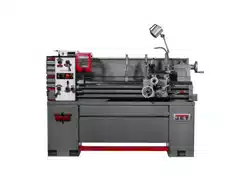Loading ...
Loading ...
Loading ...

12
To remove chuck or faceplate:
1. Support the chuck while turning three camlocks
1/4-turn counterclockwise using the chuck
wrench from toolbox. See Figure 6-5. Line up
the two marks for removal.
Figure 6-5
2. Carefully remove chuck from spindle and place
on an adequate work surface. If needed, use a
mallet at various points on back side of chuck to
help free it from spindle.
3. Inspect the camlock studs. Make sure they
have not become cracked or broken during
transit. Clean all parts thoroughly with solvent.
Also clean spindle and camlocks.
To install chuck or faceplate:
4. Cover all chuck jaws and scroll inside the chuck
with a lithium grease, such as Mobilith AW2 or
equivalent. Cover the spindle, cam locks, and
chuck body with a light film of SAE 20W oil.
5. Lift chuck up to spindle nose and press onto
spindle. Tighten in place by turning each cam
lock 1/4-turn clockwise. The index mark (A,
Figure 6-5) on camlock should be between the
two indicator arrows (B) when tight, as shown in
Figure 6-5.
If index mark (A) is not between the two
arrows, i.e. the cam turns beyond the
indicator arrows, then remove chuck and
turn camlock stud IN one full turn.
If a camlock will not engage, remove chuck
and turn camlock stud OUT one full turn.
6. Make sure chuck is secure on spindle with
camlocks correctly engaged.
NOTE: Be aware of speed limitations when using
faceplates; 1000 RPM maximum for 10” faceplates,
770 RPM maximum for 12” faceplates.
Do not interchange chucks or faceplates between
lathes without checking for correct cam locking
beforehand.
6.6 Break-in period
Do not run lathe above 560 RPM for first six hours
of operation, to allow gears and bearings to adapt
and run smoothly.
7.0 Lubrication
Lathe must be serviced at all
lubrication points and all reservoirs filled to
operating level before lathe is placed into
service. Failure to comply may cause serious
damage to lathe mechanisms.
The JET lathe is shipped with appropriate oil in the
reservoirs of headstock, gearbox and apron.
Coolant is not included.
Use clean lubricants and check levels often,
including before each working shift. To ensure
proper lubrication, oil levels should not be less than
the center of the oil sight glass. Try not to overfill, as
this may cause leakage.
Unless specified otherwise, the lubrication points
require a non-detergent, ISO 68, SAE 20W oil. The
recommended brand for this lathe is Mobil DTE® Oil
Heavy Medium or equivalent.
A quick-reference lubrication chart is provided in
sect. 12.0.
1. Chuck - Lubricate chuck daily with SAE 20W oil
through ball oiler (A, Figure 7-1).
Figure 7-1
2. Headstock - Oil must be up to indicator mark in
oil sight glass (B, Figure 7-1). Top off with SAE
20W oil. Fill by unscrewing plug (C, Figure 7-2)
atop headstock. To drain headstock, remove
drain plug (D, Figure 7-3). Drain oil completely
and clean out all metal shavings, then rinse the
casting case with kerosene. Refill after first
month of operation, then change headstock oil
every two months.
Loading ...
Loading ...
Loading ...
